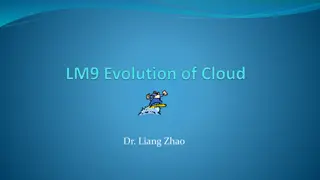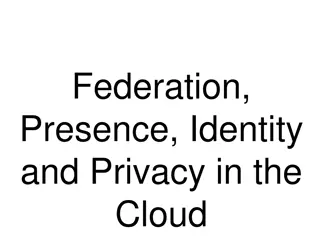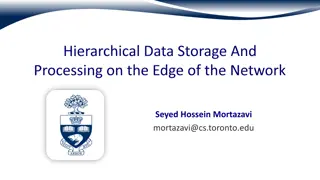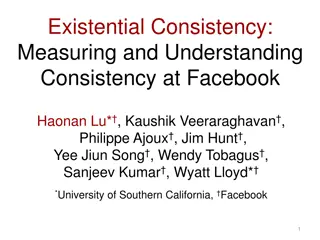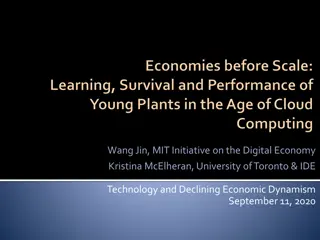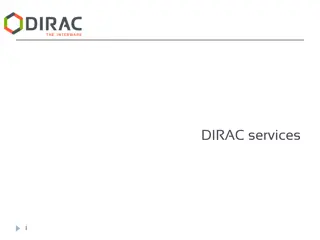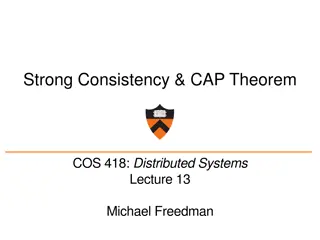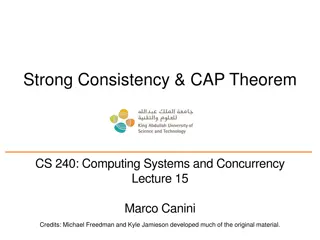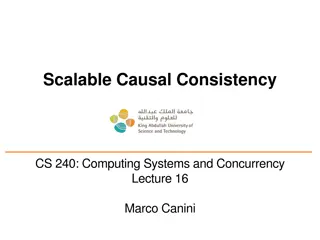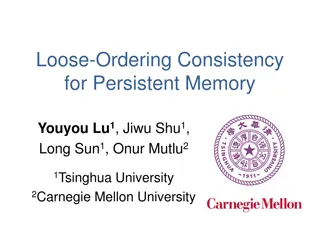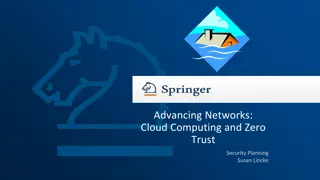Delivery Ordering for Consistency in Cloud Computing
Consistency in cloud computing relies on delivery ordering to ensure replicas stay synchronized. Learn about the importance of ordering updates, handling conflicts, impact of leaders, and FIFO ordering in maintaining consistency across replicas.
Download Presentation

Please find below an Image/Link to download the presentation.
The content on the website is provided AS IS for your information and personal use only. It may not be sold, licensed, or shared on other websites without obtaining consent from the author.If you encounter any issues during the download, it is possible that the publisher has removed the file from their server.
You are allowed to download the files provided on this website for personal or commercial use, subject to the condition that they are used lawfully. All files are the property of their respective owners.
The content on the website is provided AS IS for your information and personal use only. It may not be sold, licensed, or shared on other websites without obtaining consent from the author.
E N D
Presentation Transcript
CS5412 Spring 2014 (Cloud Computing: Birman) 1 CS5412: HOW MUCH ORDERING? Lecture XVI Ken Birman
Ordering 2 The key to consistency turns has turned out to be delivery ordering (durability is a separate thing) Given replicas that are initiallyin the same state if we apply the same updates (with no gaps or dups) in the same order, they stay in the same state. We ve seen how the virtual synchrony model uses this notion of order for Delivering membership view events Delivery of new update events CS5412 Spring 2014 (Cloud Computing: Birman)
But what does same order mean? 3 The easy answer is to assume that the same order means just what is says Every member gets every message in the identical sequence This was what we called a synchronous behavior Better term might be closely synchronous since we aren t using synchronous clocks p q r s t Time: 0 10 20 30 40 50 60 70 Synchronous execution CS5412 Spring 2014 (Cloud Computing: Birman)
As an example 4 Suppose some group manages variables X and Y P sends updates to X and Y, and so does Q P: X = X-2 Q: X = 17.3 Q: Y = Y*2 + X T: Y = 99 p q r s t Time: 0 10 20 30 40 50 60 70 The updates conflict : order matters The model keeps the replicas synchronized CS5412 Spring 2014 (Cloud Computing: Birman)
But what if items have leaders 5 Suppose all the updates to X are by P All the updates to Y are by Q Nobody ever looks at X and Y simultaneously Could this ever arise? Certainly! Many systems have leaders Consider the electric power grid: when monitoring sensors, there is often one process connected to a given sensor and only that process multicasts the updates CS5412 Spring 2014 (Cloud Computing: Birman)
Does this impact ordering? 6 Now the rule is simpler As long as we perform updates in the order the leader issued them, for each given item, the replicas of the item remain consistent Here we see a FIFO ordering: with multiple leaders we have multiple FIFO streams, but each one is behaving like a 1-n version of TCP CS5412 Spring 2014 (Cloud Computing: Birman)
What does FIFO mean for messages? 7 In other situations, FIFO means first in, first out For a message system, we mean keep the sending order used by the process that sent the messages With multiple senders, receivers could see different orderings on incoming messages. If they update the same objects inconsistency arises. But with a single sender for each kind of update, and no conflicting actions by different senders, FIFO suffices CS5412 Spring 2014 (Cloud Computing: Birman)
Revisiting our medical scenario 8 Update the monitoring and alarms criteria for Mrs. Marsh as follows Execution timeline for an individual first-tier replica A B C D Soft-state first-tier service Send Response delay seen by end-user would also include Internet latencies Send Local response delay Send flush Confirmed If A is the only process to handle updates, a FIFO Send is all we need to maintain consistency CS5412 Spring 2014 (Cloud Computing: Birman)
From FIFO to causal... 9 A fancier FIFO ordering policy can also arise Consider P and Q that both update X but with locks: First P obtains the lock before starting to do updates Then it sends updates for item X for a while Then it releases the lock and Q acquires it Then Q sends updates on X, too What ordering rule is needed here? CS5412 Spring 2014 (Cloud Computing: Birman)
Causal ordering variation 10 Update the monitoring and alarms criteria for Mrs. Marsh as follows Execution timeline for an individual first-tier replica A B C D Soft-state first-tier service Send Response delay seen by end-user would also include Internet latencies Send Local response delay Send flush Confirmed Notice that the send by C is after the send by A CS5412 Spring 2014 (Cloud Computing: Birman)
Mutual exclusion 11 Dark blue when holding the lock Lock moving around is like a thread of control that moves from process to process Our goal is FIFO along the causal thread and the causal order is thus exactly what we need to enforce In effect, causal order is like total order except that the sender moves around over time A B C D E CS5412 Spring 2014 (Cloud Computing: Birman)
Causal ordering 12 This example touches on a concept Leslie Lamport calls causal ordering A s release of the lock on X to B caused B to issue updates on X. When B was done, A resumed. The update order is A s, then B s, then A s. Lamport s happened-before relation captures this If P sends m, and Q sends m , and m then we want m delivered before m Called a causal delivery rule m , CS5412 Spring 2014 (Cloud Computing: Birman)
Same idea with several locks 13 Suppose red defines the lock on X Blue is the lock on Y p q r s t The relative ordering of X/Y updates isn t important because those events commute: they update different variables Causal order captures this too CS5412 Spring 2014 (Cloud Computing: Birman)
Can we implement causal delivery? 14 Think about how one implements FIFO multicast We just put a counter value in each outgoing multicast Nodes keep track and deliver in sequence order Substitute a vector timestamp We put a list of counters on each outgoing multicast Nodes deliver multicasts only if they are next in the causal ordering No extra rounds required, just a bit of extra space (one counter for each possible sender) CS5412 Spring 2014 (Cloud Computing: Birman)
Total ordering 15 Multicasts in a single agreed order no matter who sends them, without locking required. In Isis2 the OrderedSend protocol guarantees this. SafeSend (Paxos) has this property OrderedSend: total ordering with optimistic delivery. SaeSend: total ordering with pessimistic delivery. This is slow but offers the strongest form of durability CS5412 Spring 2014 (Cloud Computing: Birman)
Levels of ordering one can use 16 No ordering or even no reliability (like IP multicast) FIFO ordering (requires an integer counter) Causal ordering (requires vector timestamps) Total ordering (requires a form of lock). Can be implemented as a causal and total order Paxos agreed ordering (tied to strong durability) Isis2 offers all of these options CS5412 Spring 2014 (Cloud Computing: Birman)
Consistent cuts and Total Order 17 Recall our discussion of consistent cuts Like an instant in time for a distributed system Guess what: An event triggered by a totally ordered message delivery happens on a consistent cut! For example, it is safe to use a totally ordered query to check for a deadlock, or to count something The answer will be correct No ghost deadlocks or double counting or undercounting CS5412 Spring 2014 (Cloud Computing: Birman)
Isis2 multicast primitives 18 Names for Primitives Additional Options RawSend: No guarantees Flush: Durability (not needed for SafeSend) Send: FIFO In-memory/disk durability (SafeSend only) CausalSend: Causal order OrderedSend: Total order Ability to specify the number of acceptors (SafeSend) SafeSend: Paxos all come in P2P and multicast forms, and all can be used as basis of Query requests CS5412 Spring 2014 (Cloud Computing: Birman)
Will people need so many choices? 19 Most developers start by using OrderedSend for situations where strong durability isn t a key requirement (total order) SafeSend if total order plus strong durability is needed Then they switch to weaker ordering primitives if Application has a structure that permits it Performance benefit outweighs the added complexity Using the right primitive lets you pay for exactly what you need CS5412 Spring 2014 (Cloud Computing: Birman)
Virtual synchrony recap 20 A=A+1 A=3 B=7 B = B-A Non-replicated reference execution p p q q r r s s t t Time: 0 10 20 30 40 50 60 70 Time: 0 10 20 30 40 50 60 70 Synchronous execution Virtually synchronous execution Virtual synchrony is a consistency model: Synchronous runs: indistinguishable from non-replicated object that saw the same updates (like Paxos) Virtually synchronous runs are indistinguishable from synchronous runs CS5412 Spring 2014 (Cloud Computing: Birman)
Some additional Isis2 features 21 State transfer and logging User registers a method that can checkpoint group state, and methods to load from checkpoint Isis2 will move such a checkpoint to a new member, or store it into a file, at appropriate times CS5412 Spring 2014 (Cloud Computing: Birman)
Security 22 Based on 256-bit AES keys Two cases: Key for the entire system, and per-group keys. System keys: used to sign messages (not encrypt!) Per-group keys: all data sent on the network is encrypted first But where do the keys themselves get stored? CS5412 Spring 2014 (Cloud Computing: Birman)
Security 23 One option is to keep the key material outside of Isis2 in a standard certificate repository Application would start up, fetch certificate, find keys inside, and hand them to Isis2 This is the recommended approach A second option allows Isis2 to create keys itself But these will be stored in files under your user-id File protection guards these: only you can access them If someone were to log in as you, they could find the keys and decrypt group traffic CS5412 Spring 2014 (Cloud Computing: Birman)
Flow control 24 Two forms Built-in flow control is automatic and attempts to avoid overload situations in which senders swamp (some) receivers with too much traffic, causing them to fall behind and, eventually, to crash This is always in force except when using RawSend CS5412 Spring 2014 (Cloud Computing: Birman)
Flow control 25 The other form is user-controlled: You specify a leaky bucket policy, Isis2 implements it Tokens flow into a bucket at a rate you can specify http://www.commonwealthsolar.com/images/RMILeakyBucket.jpg They also age out eventually (leak) Each multicast costs a token and waits if the bucket is empty Fully automated flow control appears to be very hard and may be impractical CS5412 Spring 2014 (Cloud Computing: Birman)
Dr. Multicast 26 Something else Isis2 does is to manage the choice of how multicast gets sent Several cases Isis2 can use IP multicast, if permitted. User controls the range of port numbers and the maximum number of groups Isis2 can send packets over UDP, if UDP is allowed and a particular group doesn t have permission to use Dr. Multicast Isis2 can tunnel over an overlay network of TCP links (a kind of tree with log(N) branching factor at each level) CS5412 Spring 2014 (Cloud Computing: Birman)
Anatomy of a meltdown 27 A blend of stories (eBay, Amazon, Yahoo): Pub-sub message bus very popular. System scaled up. Rolled out a faster ethernet. Product uses IPMC to accelerate sending All goes well until one day, under heavy load, loss rates spike, triggering collapse 12000 10000 Oscillation observed messages /s 8000 6000 4000 2000 0 250 400 550 700 850 time (s) CS5412 Spring 2014 (Cloud Computing: Birman)
IPMC aggregation and flow control! 28 Recall: IPMC became promiscuous because too many multicast channels were used And this triggered meltdowns Why not aggregate (combine) IPMC channels? When two channels have similar receiver sets, combine them into one channel Filter (discard) unwanted extra messages CS5412 Spring 2014 (Cloud Computing: Birman)
Dr. Multicast 29 Application sees what looks like a normal IPMC interface (socket library) We intercept requests and map them to IPMC groups of our choice (or even to UDP) CS5412 Spring 2014 (Cloud Computing: Birman)
Channel Aggregation 30 Algorithm by Vigfusson, Tock papers: [HotNets 09, LADIS 2008] Uses a k-means clustering algorithm Generalized problem is NP complete But heuristic works well in practice CS5412 Spring 2014 (Cloud Computing: Birman)
Optimization Questions 31 o Assign IPMC and unicast addresses s.t. % receiver filtering (hard) Min. network traffic # IPMC addresses (hard) M (1) Prefers sender load over receiver load Intuitive control knobs as part of the policy CS5412 Spring 2014 (Cloud Computing: Birman)
MCMD Heuristic 32 Topics in `user- interest space FGIF BEER GROUP (1,1,1,1,1,0,1,0,1,0,1,1) (0,1,1,1,1,1,1,0,0,1,1,1) FREE FOOD CS5412 Spring 2014 (Cloud Computing: Birman)
MCMD Heuristic 33 Topics in `user- interest space 224.1.2.4 224.1.2.5 224.1.2.3 CS5412 Spring 2014 (Cloud Computing: Birman)
MCMD Heuristic 34 Topics in `user- interest space Sending cost: MAX Filtering cost: CS5412 Spring 2014 (Cloud Computing: Birman)
MCMD Heuristic 35 Unicast Topics in `user- interest space Sending cost: MAX Filtering cost: CS5412 Spring 2014 (Cloud Computing: Birman)
MCMD Heuristic 36 Unicast Unicast Topics in `user- interest space 224.1.2.4 224.1.2.5 224.1.2.3 CS5412 Spring 2014 (Cloud Computing: Birman)
Using the Solution 37 multicast Heuristic Procs L-IPMC Procs L-IPMC Processes use logical IPMC addresses Dr. Multicast transparently maps these to true IPMC addresses or 1:1 UDP sends CS5412 Spring 2014 (Cloud Computing: Birman)
Effectiveness? 38 We looked at various group scenarios Most of the traffic is carried by <20% of groups For IBM Websphere, Dr. Multicast achieves 18x reduction in physical IPMC addresses [Dr. Multicast: Rx for Data Center Communication Scalability. Ymir Vigfusson, Hussam Abu- Libdeh, Mahesh Balakrishnan, Ken Birman, and Yoav Tock. LADIS 2008. November 2008.] CS5412 Spring 2014 (Cloud Computing: Birman)
Dr. Multicast in Isis2 39 System automatically tracks membership, data rates Periodically runs an optimization algorithm Merges similar groups Applies the Dr. Multicast greedy heuristic Isis2protocols think they are multicasting, but a logical to physical mapping will determine whether messages are sent via IPMC, 1-n UDP or the tree- tunnelling layer, all automatically CS5412 Spring 2014 (Cloud Computing: Birman)
Large groups 40 Isis2 has two styles of acknowledgment protocol For small groups (up to ~1000 members), direct acks Large groups use a tree of token rings: slower, but very steady (intended for 1000-100,000 members) Also supports a scalable way to do queries with massive parallelism, based on aggregation Very likely that as we gain experience, we ll refine the way large groups are handled CS5412 Spring 2014 (Cloud Computing: Birman)
Example: Parallel search 41 Group g = new Group( /amazon/something ); g.register(LOOKUP, myLookup); Replies = g.query(LOOKUP, Name=*Smith ); public void myLookup(string who) { divide work into viewSize() chunks this replica will search chunk # getMyRank(); Could overwhelm receiver .. reply(myAnswer); } g.callback(myReplyHndlr, Replies, typeof(double)); public void myReplyHndlr(double[] fnd) { foreach(double d in fnd) avg += d; } CS5412 Spring 2014 (Cloud Computing: Birman)
Scalable Aggregation 42 Used if group is really big Request, updates: still via multicast Response is aggregated within a tree query va vb vc vd Level 0 a b c d Agg(va vb) Agg(vc vd) a c Level 1 Example: nodes {a,b,c,d} collaborate to perform a query a Level 2 Agg(va vb vc vd ) reply CS5412 Spring 2014 (Cloud Computing: Birman)
Aggregated Parallel search 43 Group g = new Group( /amazon/something ); g.register(LOOKUP, myLookup); Replies = g.query(LOOKUP, 27, Name=*Smith ); public void myLookup(int rid, string who) { divide work into viewSize() chunks this replica will search chunk # getMyRank(); .. Rval = GetAggregateResult(27); Reply(Rval/DatabaseSize); SetAggregateValue(myAnswer); } g.callback(myReplyHndlr, Replies, typeof(double)); public void myReplyHndlr(double[] fnd) { The answer is in fnd[0] . } CS5412 Spring 2014 (Cloud Computing: Birman)
Large groups 44 They can only be used in a few ways All sending is actually done by the rank-0 member. If others send, a relaying mechanism forwards the message via the rank-0 member This use of Send does guarantee causal order: in fact it provides a causal, total ordering No support for SafeSend Thus most of the fancy features of Isis2 are only for use in small groups CS5412 Spring 2014 (Cloud Computing: Birman)
Recall our community slide? 45 We ve seen how many (not all) of this was built! The system is very powerful with a wide variety of possible use styles and cases Isis2 user object Isis2 user object Isis2 user object Other group members Membership Oracle Send CausalSend OrderedSend SafeSend Query.... Isis2 library Flow Control Group instances and multicast protocols Group membership Reliable Sending Fragmentation Group-Key Mgt Views Oracle Membership Large Group Layer Dr. Multicast Platform Security TCP tunnels (overlay) Self-stabilizing Bootstrap Protocol Socket Mgt/Send/Rcv Sense Runtime Environment Report suspected failures CS5412 Spring 2014 (Cloud Computing: Birman) Bounded Buffers Message Library Wrapped locks
Isis2 offers (too) many choices! 46 Primitive FIFO/Total? Causal? Weak/Strong Durability Small/Large RawSend, RawP2PSend, RawQuery FIFO No Not even reliable Either Send, etc (same set of variants) FIFO if underlying group is small. Total order if large. No Reliable, weak durability (calling Flush assures strong durability) Either CausalSend FIFO+Causal Yes Reliable, weak Only small OrderedSend Total No Reliable, weak Only small SafeSend Total No Reliable, strong Only small Aggregated Query Total No Reliable, weak Only large Also: Secure/insecure, logged/not logged For SafeSend: # of acceptors, Disk vs. in-memory durability CS5412 Spring 2014 (Cloud Computing: Birman)
Choice or simplicity 47 Many developers just use Paxos Has the strongest properties, hence a good one-size- fits-all option. SafeSend with disk durability in Isis2 But Paxos can be slow and this is one reason CAP is applied in the first tier of the cloud Isis2 has a wide range of options Intended to permit experiments, innovative ideas Pay for what you need and use SafeSend if you like flexibility permits higher performance CS5412 Spring 2014 (Cloud Computing: Birman)
Recommendation? 48 We urge people who use Isis2 to initially start with very simple applications and styles of use Use OrderedSend for everything. Until you are familiar with the system, don t try to put a group in front of a replicated database that needs to tolerate total failure/restarts Fancy features are for fancy use cases that really need them many applications won t! CS5412 Spring 2014 (Cloud Computing: Birman)


